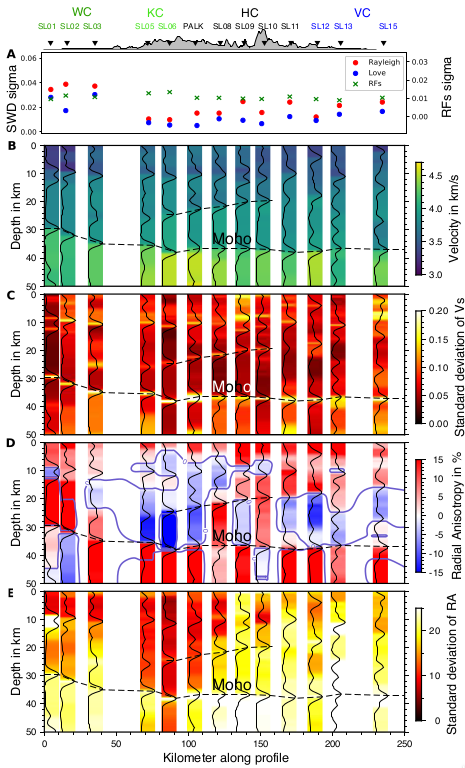Uncertainty Quantification – From Data to Reliable Knowledge (UQ)
The estimation of seismic hazard, exploitation of the underground for mineral resources, geothermal energy generation and storage, and understanding of geodynamic processes require knowledge and interpretation of the structure of the subsurface. Seismic tomography is a technique that uses model inference of seismic waves either directly or in combinations of secondary measurements (e.g., surface wave dispersion curves, travel times, and preprocessed traces) to characterize the Earth’s interior. We will concentrate on methods based on secondary observables and simplified physics, as they are amenable to deal with large numbers of observations and direct search methods are feasible. A challenge here is that the underlying distribution of data uncertainty is poorly known and needs to be estimated as part of the analysis process. The distribution of the true data error as well as variability of the signal tend to have long tails. We will develop and test techniques for distinguishing outliers from extreme values resulting from structural variations. Additional uncertainty due to simplification of the physics of wave propagation can often be captured stochastically. In the analysis stage, additional physical insight is often used to guide the exploration of the posterior probability space. In this project, we will evaluate the implications of these additional constraints for UQ. Finally, the three-dimensional (3D) models resulting from the geophysical imaging pipeline are interpreted by geologists (visual interpretation) or inform numerical geodynamic models (quantitative interpretation). In both cases, it is crucial to adequately communicate uncertainties to avoid misinterpretations, while at the same time the representation of complex joint probability density functions needs to remain manageable.
In the first stage, we focus on uncertainty quantification in radial anisotropy based on the transdimensional hierarchical Bayesian method. The hierarchical transdimensional Bayesian approach is able to provide uncertainty estimates taking fully into account the nonlinearity of the forward problem. Under the Bayesian framework, the mean and the variance of the ensemble containing a large set of models are interpreted as the reference solution and a measure of the model error respectively. We then applied the method to a temporary broadband array covering all of Sri Lanka.
In the second stage, we propose a one-step 3-D direct inversion based on the reversible jump McMC and 3-D Voronoi tessellation. Joint inversion is usually performed in two steps: first invert for 2-D surface wave phase (or group) velocity maps and then invert 1-D surface wave and RFs jointly to construct a 3-D spatial velocity structure. However, in doing so, the valuable information of lateral spatial variations in velocity maps and dipping discontinuities in RFs may not be preserved and lead to biased 3-D velocity structure estimation. Hence, the lateral neighbours in the final 3-D model typically preserve little of the 2-D lateral spatial correlation information in the phase and group velocity maps. To improve the above issues, we inverted for 3-D spatial structure directly from frequency-dependent travel time measurements and receiver functions.

Time frame
- 2020 - 2024
Principal Investigator
- F. Tilmann GFZ)
- T. Ryberg (GFZ)
Staff
- Kuan-Yu Ke (GFZ)
Funding
- Gefördert durch die Helmholtz-Gemeinschaft als Pilotprojekt im Bereich der Informations- und Datenwissenschaften
Cooperation/Partner
- Karlsruhe Institute of Technology (KIT) -Koordinator
- Universität Bielefeld (Uni BI) - Koordinator
- Alfred-Wegener-Institut (AWI)
- Forschungszentrum Jülich (FZJ)
- Helmholtz Institute for Functional Marine Biodiversity (HIFMB)
- Carl von Ossietzky Universität Oldenburg (Uni OL)
- Helmholtz Zentrum München (HMGU)
- Helmholtz-Zentrum Geesthacht (HZG)
- Helmholtz-Zentrum für Umweltforschung (UFZ)
Project website
Research Unit(s) (POF/MESI/GIPP)
Publication
- Tilmann, F., Sadeghisorkhani, H., Mauerberger, A. (2020): Another look at the treatment of data uncertainty in Markov chain Monte Carlo inversion and other probabilistic methods. - Geophysical Journal International, 222, 1, 388-405. https://doi.org/10.1093/gji/ggaa168




